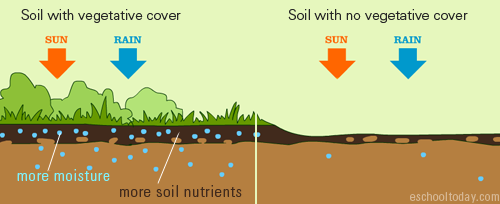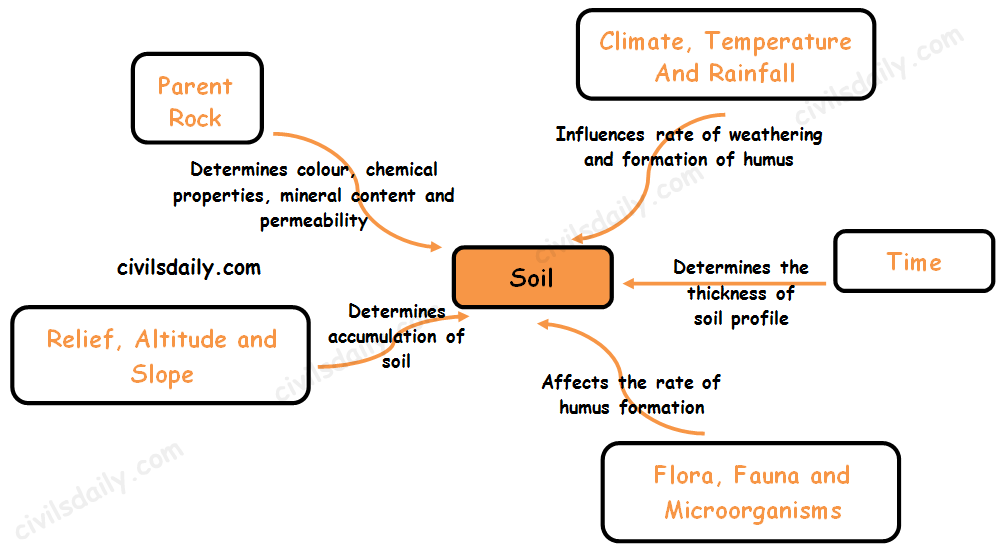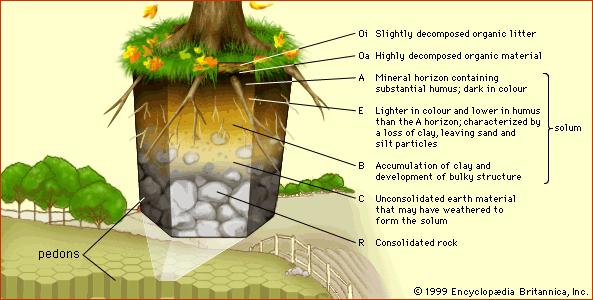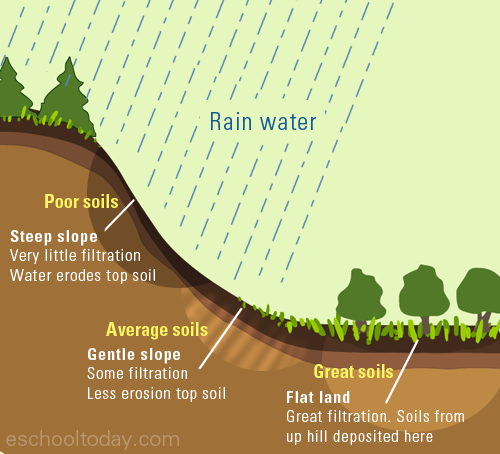The major factors responsible for the formation of soil:
The major factors affecting the formation of soil are relief, parent material, climate, vegetation and other life-forms and time. Besides these, human activities also influence it to a large extent.
1. Parent Material
The parent material of soil may be deposited by streams or derived from in-situ weathering. Soil inherits many properties from the parent material from which it forms, for example, the mineral composition, the colour, the particle size and the chemical elements.
For Example,
- The peninsular soils reflect the parent rock very much.
- The ancient crystalline and metamorphic rocks which are basically granite, gneiss and schist form red soils on weathering because they contain iron oxide.
- Soils derived from lava rocks are black coloured.
- Sandy soils are derived from sandstone.
- At the same time, the soils of the northern plains are transported and deposited from Himalayan and peninsular blocks, so they have little relation to rock material in-situ.
2. Climate
The role of climate is to vary the inputs of heat and moisture. It affects the rate of weathering of the parent rock. Hot and humid environments, in general, witness the most rapid weathering of parent materials.
- Role of precipitation: In areas that experience a lot of rainfall, water percolating down through soil tends to leach nutrients and organic matter out of the upper layers, unless modified by other soil components like plant roots.
- E.g. the soils underlying tropical rain forests tend to be nutrient-poor because of intensive leaching due to heavy rains; most of the nutrients are stored in the lush vegetation itself.
- Conversely, in arid regions with little annual precipitation, high rates of evaporation encourage the accumulation of salts in the soil.
- Role of temperature: Solar energy, usually expressed as temperature, controls the form of water falling onto the soil surface as well as in the soil. Also, it increases the rate of reactions, such as chemical reactions, evapotranspiration and biological processes. Wide fluctuations in temperature, especially in the presence of water cause shrinking and swelling, frost action and general weathering in soils.
- E.g. Laterite soils are found in alternate wet and dry climate.
- In Rajasthan, both granite and sandstone give birth to sandy soil irrespective of parent rock because of high temperature and wind erosion.
3. Biota (Flora, Fauna and Microorganisms):
Biota, in conjunction with climate, modifies parent material to produce soil.
- The kind and amount of plants and animals that exist bring organic matter into the soil system as well as nutrient elements. This has a great effect on the kind of soil that will form.
- E.g. Soils formed under trees are greatly different from soils formed under grass even though other soil-forming factors are similar.
- The roots of plants also hold the soils and protect them from wind and water erosion. They shelter the soils from the sun and other environmental conditions, helping the soils to retain the needed moisture for chemical and biological reactions.
 Source
Source
5. Topography (Relief, Altitude and Slope):
Topography is often considered a passive factor modifying the effects of climate.
Topography redistributes the water reaching the soil surface. Runoff from uplands creates wetter conditions on the lowlands, in some cases saline sloughs or organic soils. Thus, as a redistributor of the climate features, topography affects soil processes, soil distribution and the type of vegetation at the site.
Source
6. Time:
Soils can take many years to form. Younger soils have some characteristics from their parent material, but as they age, the addition of organic matter, exposure to moisture and other environmental factors may change its features. With time, they settle and are buried deeper below the surface, taking time to transform. Eventually, they may change from one soil type to another.
Look at the following diagram for a quick revision of the above-discussed facts:

Note:
The above factors are not mutually exclusive but interdependent. For example, the kind of vegetation found at any one location on the earth’s surface is dependent on climate, parent material, topography, time and, in fact, soil. It is obvious that numerous combinations of the factors are possible. This leads to many different kinds of soils, each representing a certain combination of the factors of soil formation.
Soil Profile
As we discussed earlier, soil development begins when plants and animals colonize rocks or deposits of rock fragments. Once organic processes start among mineral particles or rock fragments, chemical and physical differences begin to develop from the surface down through the parent material.
Initially, vertical differences result from surface accumulations of organic litter and the removal of fine particles and dissolved minerals by percolating water that deposits these materials at a lower level.
Over time, as climate, vegetation, animal life, and the land surface affect soil development, this vertical differentiation becomes increasingly apparent.
If you could dig a massive trench, about 50-100ft vertically downwards into the ground, you will notice that you would have cut through various layers of soil types. A look at the layers from a distance gives one a cross-section view of the ground (beneath the surface) and the kind of soils and rocks it is made up of. This cross section view of soil from the surface down to the parent material is called a Soil Profile.
The Soil Profile is a product of the balance between the soil system inputs (i.e. additions) and outputs (i.e. losses) and the redistribution of (i.e. translocations), and chemical changes (transformations) in the various soil constituents.
The soil profile is made up of layers, running parallel to the surface, called Soil Horizons. These layers are distinguished by their physical and chemical properties.
Most soils have three major horizons. These are A Horizon, B Horizon and C Horizon. Aside these three, there are also the O, E and R horizons. How are they different? Let’s see!

Source [Also, Solum – true soil]
- O-Horizon: The O-horizon is very common to surfaces with lots of vegetative cover. It is the layer made up of organic materials such as dead leaves and surface organisms, twigs and fallen trees. In fact, the ‘O’ designation refers to this horizon’s high content of organic debris and humus. It is often black or dark brown in colour, because of its organic content. It is the layer in which the roots of small grass are found.
The A-Horizon: The A horizon, immediately below the O horizon, is usually known as the topsoil. It is the top layer soil for many grasslands and agricultural lands. In general, A horizons are dark because they contain decomposed organic matter.
The E-Horizon: The E horizon is usually lighter in colour, often below the O and A horizons. It is often rich in nutrients that are leached from the top A and O horizons. It has a lower clay content and is common in forested lands or areas with high-quality O and A horizons.
The B-Horizon: Below the E-horizon is the B-horizon, a zone of accumulation, where much of the nutrients removed from the A and E horizons are deposited. It is the layer in which the roots of big trees end. There is a close relationship between the A and B horizons. Translocations, as well as, many biological and chemical reactions take place between them. The B horizon, however, tends to be more stable than the A for short term differences.
The C-Horizon: The C horizon is the weathered parent material from which the soil has developed. This layer is the first stage in the soil formation process and eventually forms the above two layers. The C horizon is also known as saprolite.
The R-Horizon: It is the unweathered parent material.


